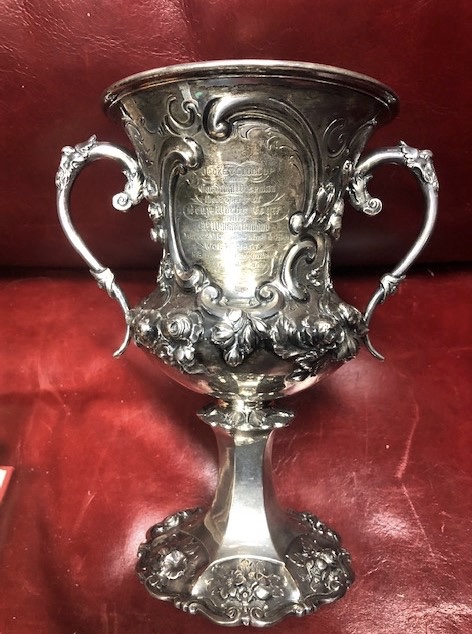1
Influenza Emergency Worker Breast Badge
Badge in white metal, pin-backed, reverse usually plain but some examples have ‘Angus & Coote’, 1919. Size 2.5 x 3.8 cm. Photo courtesy Noble Numismatics Pty Ltd
During the 1918–1919 worldwide influenza pandemic, up to 40 million people are believed tohave died. The disease arrived in Victoria in early 1919, and spread to NSW by 27 January. By the time the pandemic ended in September that year,more than 6,000 people had died of the disease in NSW.
Emergency Worker volunteers were issued with this badge. The Administrative Committee for the influenza epidemic was headquartered in the Sydney Showground at Moore Park. From here, they administered 60 depots established in various municipalities.
Some quotes from the media of the day:
Influenza masks: Like using barbwire fences toshut out the flies, Masks are a fool’s remedy.
Alternative: Bovril… I, regard it as great protection against Influenza.
Social distancing: Owing to the influenza trouble several country shows have been abandoned. A sort of meeting trouble halfway.
Inoculations: The Health Department is keeping a record of every case. So far, it says, nothing very ‘startling’ either for or against inoculation.
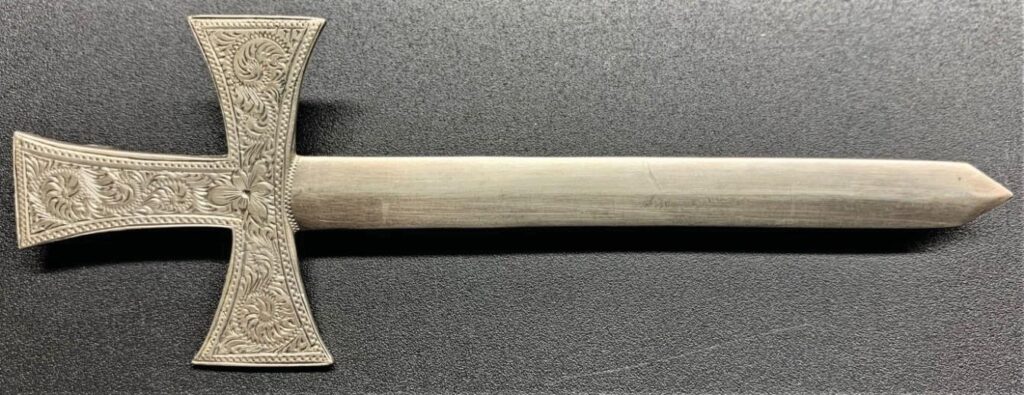
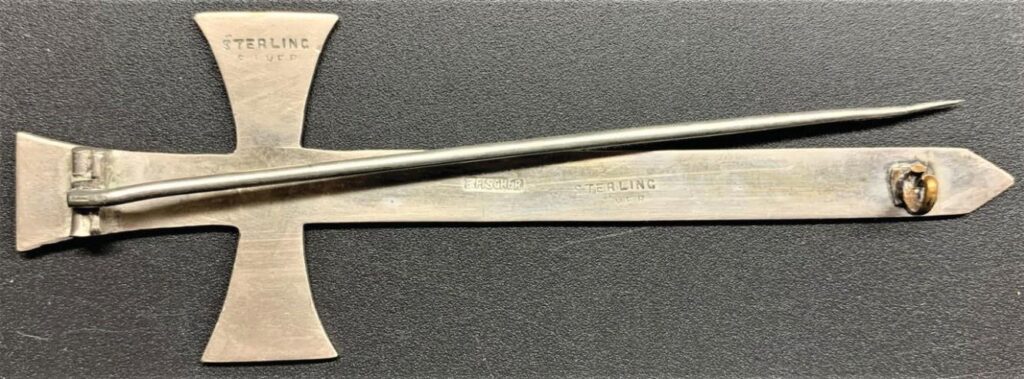

2
Scottish Broad Sword Kilt Pin by E Fischer, Geelong
Edward Fischer, Geelong, kilt pin in the shape of a broad sword c 1884. Sterling silver, 11.8 cm long, 4 cm wide
The numerous Scottish migrants in Geelong brought many traditions with them. Scottish societies were established from the 1850s onwards, including Comunn na Feine, the Caledonian Society and the Highland Society. These groups supported the ill or widowed and held social gatherings, concerts and sporting meets. Men wore their kilts at these events, held in place by kilt pins like this.
Edward Fischer (1828–1911), son of a jeweller in Vienna, arrived in Victoria in the early 1850s,and had set up his business by 1857. His large output and skill ensured that he dominated the jewellery trade in Geelong, at first in Market Square in Moorabool St and later in Ryrie St, where he was last listed in 1891. He sold the Geelong business to his foreman Harry Page.
The firm carried on by his sons Harry Caspar and Edward Robert Fischer relocated to 190 Collins St, Melbourne, trading as E. Fischer and Son, Manufacturing Jewellers, Watchmakers and Opticians from 1895 to 1916. Fischer marked his work FISCHER or E. FISCHER, GEELONG.
Items made in Geelong were not always stamped with the Geelong punch. Fischer is best known for his series of gold cups for the Geelong Cup and the first locallymade Melbourne Cup (1865). He also received orders from interstate, NZ and Fiji.
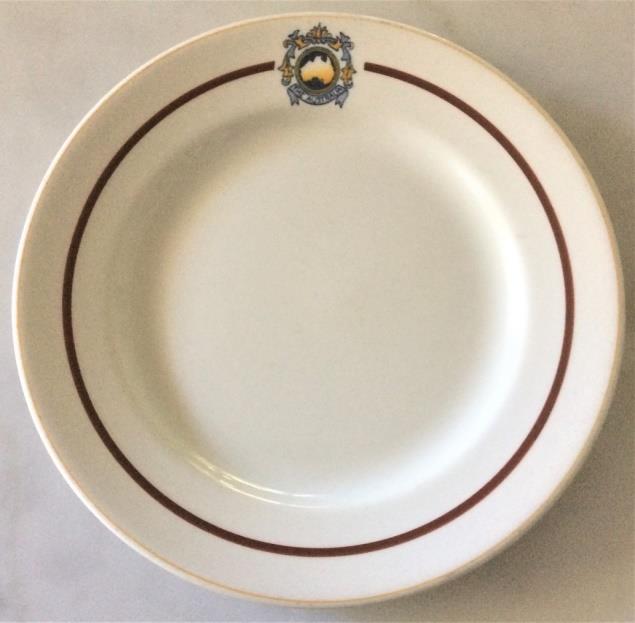
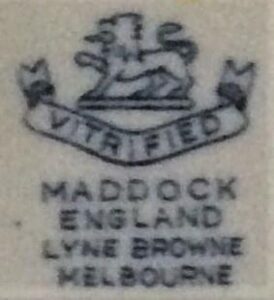
3
Hotel Ware for the Australian Market
Ceramic bread and butter plate. Diameter: 20 cm
The original Hotel Australia plate in VS&T 12 was manufactured by Grindley Hotel Ware Co, England and distributed by Gibsons and Patersons Pty Ltd of Sydney. This new Hotel Australia item has the more elaborate, (1955) multi-coloured post-war map pattern with scrolls and a banner and is marked Maddock England (manufacturer) and Lyne Brown Melbourne (distributor).
A quick search of the internet produced other plates also marked Maddock England and Lyne Brown Melbourne, manufactured for Cooke & Wallis Ltd in Adelaide, a catering business. All we can conclude is that Australian hotels, restaurants and businesses had their personalised crockery made in England by a variety of manufacturers.
In the late 1800s, two Maddocks, father Thomas and son John, founded several ceramic firms in the city of Trenton, Staffordshire, England. John eventually founded his own company in Trenton. Thomas Maddock, born in 1818 into a Burslem, Staffordshire family of potters, arrived in New York in 1847. Having served his apprenticeship as a decorator in England, Thomas and his partner William Leigh set up a china decorating company in New York City, the first of its kind in the United States.
By 1873, Thomas had made his way back to Trenton and formed a profitable partnership with Millington and Astbury manufacturing earthenware. They produced “toilet sets” – wash basins, pitchers, chamber pots and slop jars, mugs and toothbrush holders – dinnerware, and other household pottery utensils.
Thomas Maddock’s primary interest, however, was in finding a way to produce and sell sanitary ware, ie: toilets, in the United States. For most of the nineteenth century indoor plumbing and toilets were a luxury only the wealthy could afford. In 1873, there were no manufacturers of sanitary ware in the United States, all toilets coming from England.
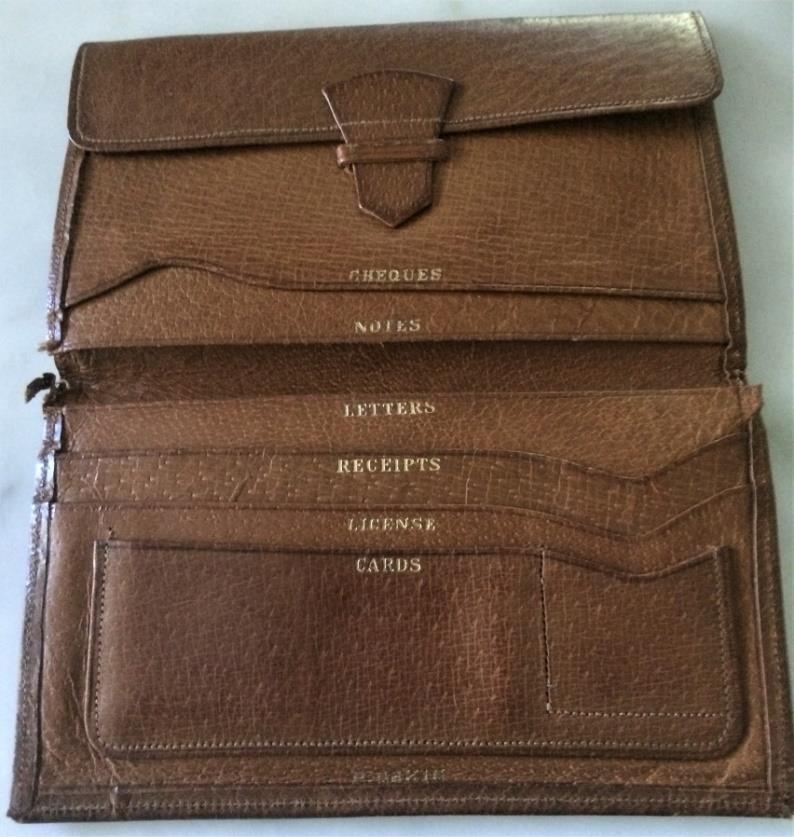
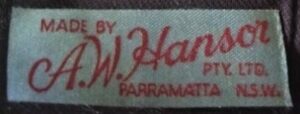
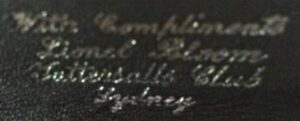
4
Pig Skin Wallet
Size: 15.4 x 18.5 cm (open)
This item illustrates what we can discover from simple objects.
A W Hansor Pty Ltd, leather manufacturer, was established in Meagher St Chippendale, Sydney in 1919. In 1932 the company pioneered the glove industry in Australia. Up until that time all gloves were imported. Initially it produced kid gloves, but for the war effort in 1941, they concentrated on the manufacture of industrial type gloves. A branch factory was opened in Wallsend in March 1946, for the manufacture of industrial gloves, some of which were for government contracts.
The Chippendale business moved to a new £12,000 factory in North Parramatta in July 1947, providing employment for local people. Initially they made kid gloves but planned to diversify into fancy leather goods such as wallets and pouches. The date of the wallet would therefore be post 1947. The owner of the business, Arthur William Hansor died on 18 February 1965 and the business continued after his death to at least the mid 1970s. Most of the factory workers were women who were sewing machinists.
Lionel Bloom was a colourful character in Sydney racing circles, described in the press of the day as a ‘dapper bookie boy’ and one of the Australian Jockey Club’s foremost paddock bookmakers. He left for England in March 1934 with his ‘Man Friday’ Frank Holmes having been offered a chance by the racing authorities to field during the coming season; he was guaranteed a stand in the Tattersall’s ring.
By August 1934 he was back in Sydney, at the Rosehill course, wearing in his buttonhole one of the largest and most beautiful carnations seen out that season. In 1937 he appears again in the press, the victim of a forged racing ticket. Sadly his son, also Lionel an RAAF solo training pilot died when his plane crash landed near Junee in April 1943. The last mention of Lionel was when he donated £100 to the Sydney Chevra Kadisha in Woollahra for their building fund. He died in Sydney in February 1957.
These two facts date the wallet 1947-1957.
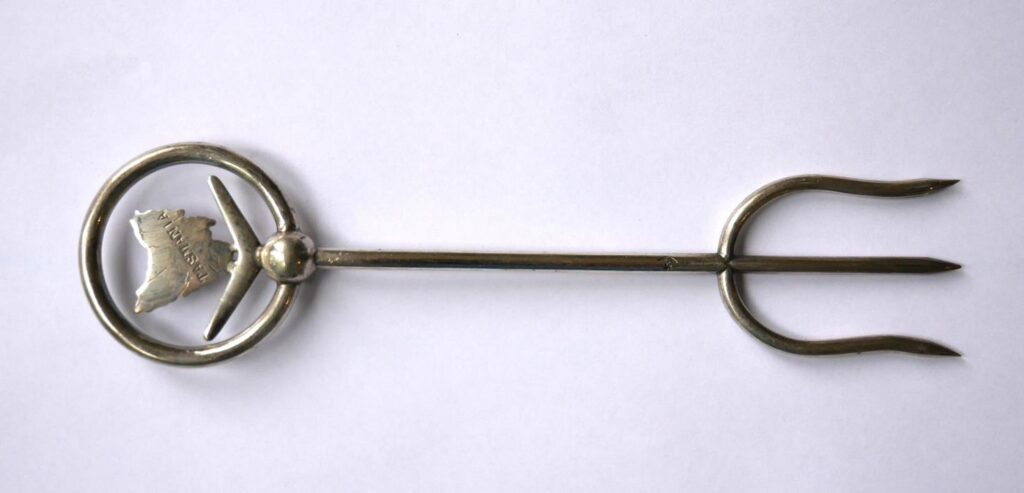


5
Bread Fork by Stokes & Sons
Size: 21 cm x 5.3 cm
A trident bread fork with a decorative handle with a ring enclosing a map of Tasmania atop a boomerang, the handle stamped MADE IN AUSTRALIA, EPNS, S & S and an ’S’ in a star over a boomerang. It was made by Stokes and Sons, a family company which was a Victorian institution from 1855– 2015. Ken Cavill wrote a comprehensive article, “The Silverware of Stokes and Sons” in Australiana May 1986.
Thomas William Stokes completed a five-year apprenticeship in Birmingham, UK before coming to Australia to seek gold. Failing to find gold, he set up business in central Melbourne in 1855 working as a die- sinker, making medals, buttons and silver goods. The company survived for 160 years despite fires and insolvency. Three generations of the family worked there across the years. The premises moved from central Melbourne to Brunswick and later to Ringwood. They made buttons for most uniforms: police, railway employees, government houses and the military forces including the Boer War and WW2. They made tokens which were the early unofficial currency due to a shortage of official currency before that was made illegal. They made medals and badges for ‘everything’ from the 1861 Burke and Wills expedition, the 1901 Federation of Australia as well as millions of Rising Sun badges for the forces, a silver wedding present for Princess Elizabeth and Phillip, and even the insignia for the Boy Scouts. During WW2 they made eyepiece rims for gas masks and by 1950s were making electrical and automotive components. In the 1980s the firm employed nearly 800 people. Since then the badges and buttons business was sold and cheaper overseas manufacturing has seen the company’s local production decline.
Cavill lists Stokes’ marks but not with specific dates. A number of these forks have Australiana themes: kangaroos, kookaburra etc. Another Stokes fork with the map of Australia on its handle has the word Australia stamped across it; does the word obliterate the NT/SA border or does this one predate the 1911 separation of the territory? Some forks are advertised as toasting forks but they are far too short for this.
Editor’s comment: Bread forks have three tines and a short to medium length handle, used to serve bread from a basket. Two styles of bread forks were made in the 1800s and early 1900s, one with flaring tines that resemble a trident as in this example, the second with straight tines like a small toasting fork. Bread forks were made in sterling silver or EPNS, the latter much cheaper. Cavill suggests that the mark on this fork was first used in 1911 and appears on much of the later EPNS work. I suggest this example is pre–WW1 when Tasmania was a popular tourist destination for mainland Australians.
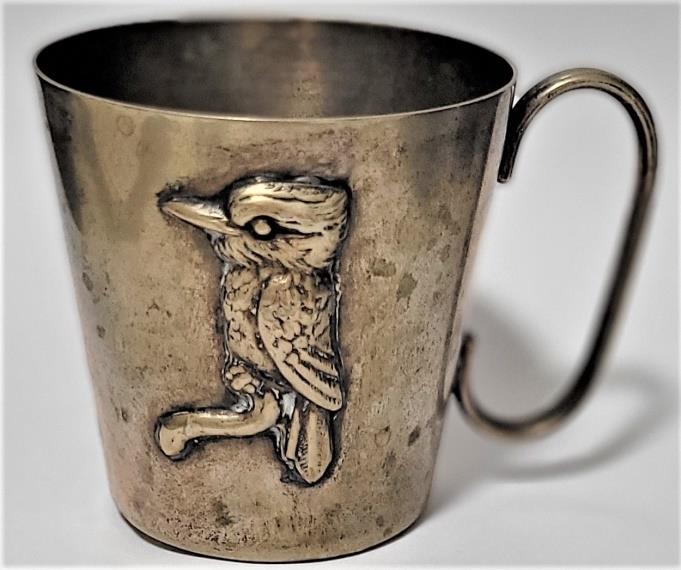
6
Child’s Kookaburra Cup
Height 68 mm, Maker unknown
A Trove search under ‘kookaburra cup’ revealed only one retailer, H.F. Smith Ltd. who advertised them. They had two shops in Brisbane, one at the corner of Queen and George Streets and the other in the Town Hall. The retailer only advertised them in 1921 and the advertisement heading was ‘Souvenir Goods’. They were part of a set: ‘EPNS Kangaroo, Emu and Kookaburra Child’s cup 30/-’. They also advertised EPNS of the same fauna on napkin rings, bread forks and ashtrays and Sterling Silver spoons.
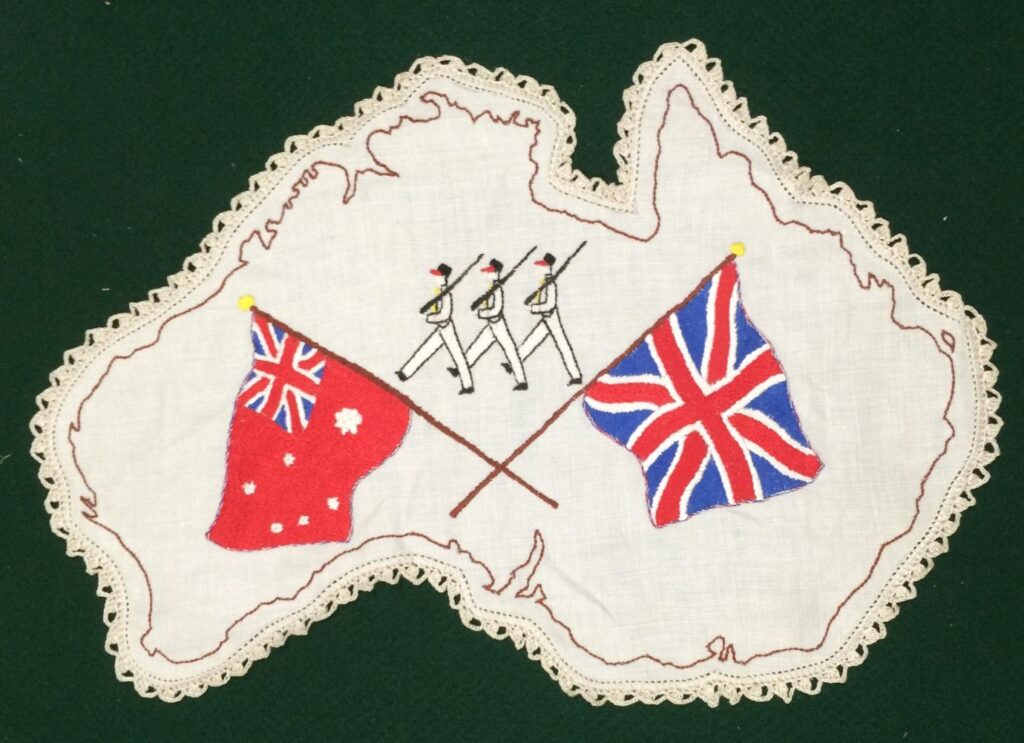
7
Semco Home Front Linen Doyley
Depiction of three stylised soldiers marching, and crossed Australian and British flags within a map of mainland Australia.
This linen needlework was sold in haberdashery departments around Australia and designed to boost morale on the ‘Home Front’ during WWII. Semco linen products when sold had design traced-lines to assist women to hand sew over them. This form of needlework was highly popular in the 1940s through to the 1960s.
In 1907 Stanley E Mullen established Semco in Melbourne, with the firm’s name using the three letters of his initials (SEM-CO]. In 1911 the premises were destroyed by fire and shortly after this the business was run by C H Mylis. By the early 1920s Semco had moved to Cheltenham Road, Black Rock. After the war the firm stayed in production until the early 1990s when it was taken over by cotton merchants, Coates-Paton Pty Ltd. The Black Rock factory closed and the office moved to Mulgrave, while factory work shifted to Launceston in Tasmania before being moved to New Zealand.
Editor’s Note: Interestingly the map shows an island near Brisbane but not the island state of Tasmania. The map design was later used for doylies that depict Australian flora and Fauna.
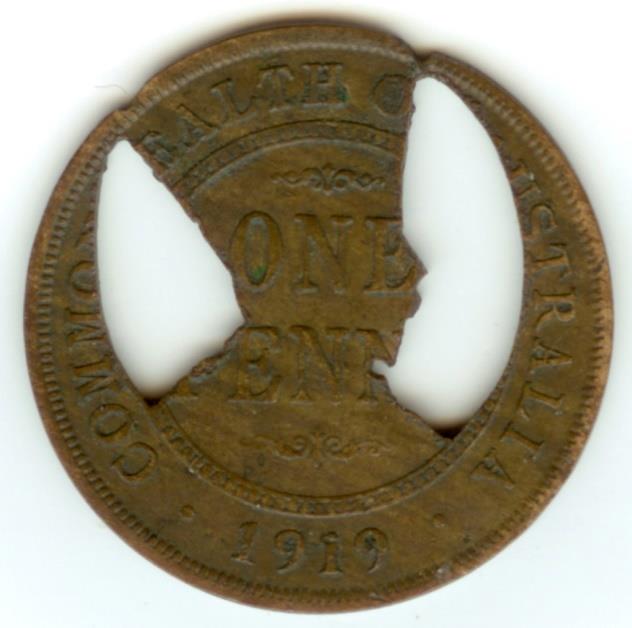
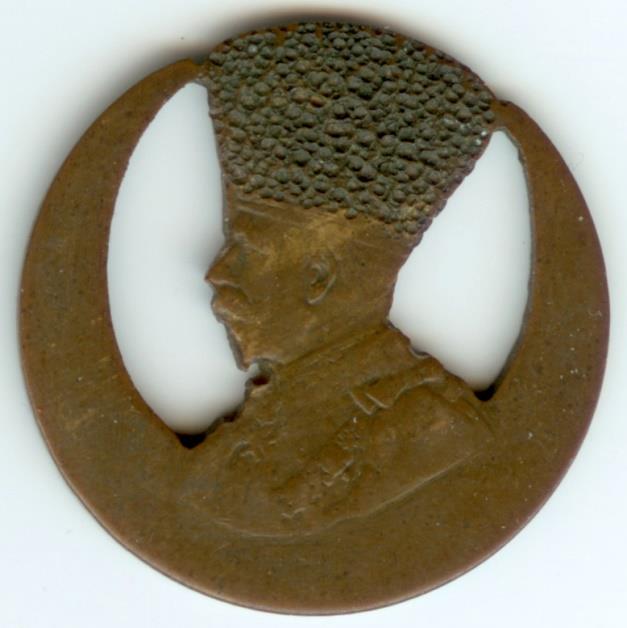
8
Fretwork on Australian 1919 Penny
The bust of King George V has had his crown replaced with a fez, the wording around the edge has been smoothed down, and the fretwork has created an image of a crescent moon, being the symbol of Ottomans, thus metamorphosing George V into Mustafa Kemal Atatürk.
Mustafa Kemal Atatürk (1881-1938) came to prominence for his role in securing the Ottoman Turkish victory at Gallipoli and later became the Republic of Turkey’s first president serving from 1923 until his death in 1938. He is considered the founding father of modern Turkey.
The host coin is a 1919 Australian penny struck at the Melbourne Mint. The obverse depicts the effigy of George V designed by Australian sculptor Edgar Bertram Mackennal (1863-1931) knighted 1921. The reverse was designed by William James Blakemore (1871-1945) a London Mint die engraver.
There are two schools of thought as to who crafted this memento. One view is that it was a serviceman who had served in the Middle East and fought against the Ottoman Empire either at Gallipoli or other locations in the Middle East, and that he made it while recovering from effects of the war. Not surprisingly it does not have a brooch clip; whilst beautifully made, no-one in Australia would have wanted to wear it when made, so it was probably tucked away in a drawer and forgotten.
The second view is that it was made by a Turkish sympathiser or a migrant from Turkey. The wear on the remaining parts of the penny suggests that it was made some years after the coin was struck, when Atatürk came to power, or when he died.
Editor’s note: Altering images of royalty and head of states on coins has been practised in Australia and elsewhere, in particular during war time when men had time on their hands; being a POW or convalescing. The most common examples of this art were created on the Boer War leader, Paul Kruger’s coins. His adaptations usually have him smoking a pipe and wearing a hat, rather than transforming him to become another person.


9
WWII Brooch from Australian Shilling
King George VI wearing an Australian soldier’s slouch hat, complete with the rising sun badge, and chin strap, alludes to the bond between Britain and Australia during WWII. When Britain declared war against Germany, Australia also declared war at the same time (3 September 1939).
While the support of Britain was not as strong as the First World War, the majority of Australians were of British stock and many signed up to fight. After Australian troops left North Africa to defend Australia from the Japanese in 1942 this soured the relationship with Churchill, despite the Air Force and Navy remaining in the European theatre.
The owner of this brooch believes it was most likely created during the years 1939 to 1942 when Australia and Britain were solely focused on defeating Germany and members of the Axis. However, it was certainly made during WWII.
The host Coin: an Australian Shilling c 1938-1944. From 1938 to 1944 shillings were struck at the Melbourne Mint, and some in 1942 and 1944 were minted at the San Francisco Mint. No shillings were struck in 1945. The obverse depicts George VI without a crown, facing left and this image was designed by Thomas Humphrey Paget (1893- 1974), he was English born and awarded an O.B.E. (Civil) in 1948. The reverse depicts a Merino ram’s head designed by George Kruger Gray (1880-1943) an English engraver. The ram was the grand champion Merino ram at the 37th Annual Sydney Sheep Show of 1932 and was exhibited by Charles Mills (Uardry) Pty Ltd, Uardry Merino stud, Hay, in the NSW Riverina.

10
Fundraising Buttons for Queen Victoria Hospital SA
The badges are ‘tinnies’ (tin with a lacquered paper applied), plain paper, lacquered paper and one example is a peel off version – the latter is rare as they were discarded at the end of the day. Surprisingly many button day badges survive. Some clearly refer to a building appeal, and the stork bringing a baby was a popular theme. One example refers to babies being the ‘Empire’s Asset’ that can be dated to the early post WWII era – baby boomers!
In 1902 the hospital, located at 160 Fullarton Road, opened and was called the Queen’s Home, in 1939 it became known as Queen Victoria Maternity Hospital and in 1966 the name changed again to Queen Victoria Hospital.
In 1945 the State Government agreed to subsidise the Hospital’s fund raising efforts on a ‘pound for pound’ basis. In 1946 The QVMH was declared a public hospital under the provisions of the Hospital Benefits Act 1946. As a public hospital it was entitled to Commonwealth Government subsidy.
A 1957 Women’s Weekly advice column listed The Queen Victoria Maternity Home, among other institutions, as a place where teenage girls with an ‘unwanted pregnancy’ could go for help.
A seven-storey wing was added in in the early 1960s and in 1989 the hospital was closed.
Cooee
Call for Australiana Volunteers
We need 10 articles every 2 months
Tell us about your items: humble or valuable
Tell your children you answered the call in the hour of need! Do your Bit
Editorial Team
Peter Lane pnj.lane@bigpond.com Yvonne Barber ypbarber@hotmail.com
To join the editorial team or submit an item for the VS&T Report, please contact Peter at pnj.lane@bigpond.com



